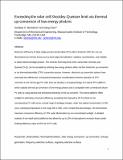Exceeding the solar cell Shockley–Queisser limit via thermal up-conversion of low-energy photons
Author(s)
Boriskina, Svetlana V; Chen, Gang
DownloadMain article (823.5Kb)
PUBLISHER_CC
Publisher with Creative Commons License
Creative Commons Attribution
Terms of use
Metadata
Show full item recordAbstract
Maximum efficiency of ideal single-junction photovoltaic (PV) cells is limited to 33% (for 1 sun illumination) by intrinsic losses such as band edge thermalization, radiative recombination, and inability to absorb below-bandgap photons. This intrinsic thermodynamic limit, named after Shockley and Queisser (S–Q), can be exceeded by utilizing low-energy photons either via their electronic up-conversion or via the thermophotovoltaic (TPV) conversion process. However, electronic up-conversion systems have extremely low efficiencies, and practical temperature considerations limit the operation of TPV converters to the narrow-gap PV cells. Here we develop a conceptual design of a hybrid TPV platform, which exploits thermal up-conversion of low-energy photons and is compatible with conventional silicon PV cells by using spectral and directional selectivity of the up-converter. The hybrid platform offers sunlight-to-electricity conversion efficiency exceeding that imposed by the S–Q limit on the corresponding PV cells across a broad range of bandgap energies, under low optical concentration (1–300 suns), operating temperatures in the range 900–1700 K, and in simple flat panel designs. We demonstrate maximum conversion efficiency of 73% under illumination by non-concentrated sunlight. A detailed analysis of non-ideal hybrid platforms that allows for up to 15% of absorption/re-emission losses yields limiting efficiency value of 45% for Si PV cells.
Date issued
2013-10Department
Massachusetts Institute of Technology. Department of Mechanical EngineeringJournal
Optics Communications
Publisher
Elsevier
Citation
Boriskina, Svetlana V. and Chen, Gang. “Exceeding the Solar Cell Shockley–Queisser Limit via Thermal up-Conversion of Low-Energy Photons.” Optics Communications 314 (March 2014): 71–78 © 2013 Elsevier B.V.
Version: Author's final manuscript
ISSN
0030-4018